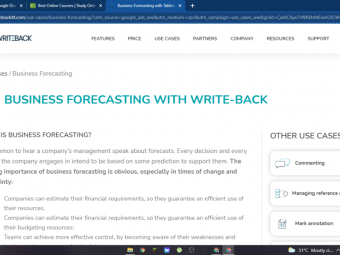Cfa Level 1 Quantitative Methods
Tags: CFA
QM course covering the CFA level I curriculum|Plus 84 practice questions with answers|Prof. James Forjan, PhD, CFA
Last updated 2022-01-10 | 4.8
- CFA Level 1 Quantitative MethodsWhat you'll learn
* Requirements
* Be enrolled in the CFA ProgramDescription
Wouldn’t it be great if studying for the CFA® exam was as easy as watching TV?
With AnalystPrep video lessons, it is!
Our video lessons follow the same pattern as the 57 readings from the curriculum, with the exception that we emphasize on the LOS – the learning objectives on which exam questions are based! Plus we add convenient mathematical examples throughout so that you are better prepared on the big day.
Professor James Forjan, who has taught college-level finance classes for over 23 years, summarizes Level I of the CFA exam curriculum in 57 clear and simple videos. With a clear passion for teaching, Prof. Forjan has worked in the CFA exam preparation industry for decades after earning his charter in 2004. His resume includes:
BS in accounting
MSc in Finance
PhD in Finance (minor in Economics and two PhD level classes in Econometrics)
Has taught at different 6 universities (undergraduate and graduate-level Finance classes)
Co-author of investment books
Has crafted, edited, updated, and upgraded a multitude of CFA exam type questions at all levels
And much more…
This course includes:
Videos covering each Quantitative Methods reading (downloadable)
Downloadable Powerpoint slides (in PDF format)
84 Quantitative Methods practice questions with detailed answers (PDF files)
In this course, Prof. James Forgan, PhD, CFA, summarizes each Quantitative Methods concept so you can learn or review all of the important mathematical formulas and calculation steps from the CFA Level 1 QM chapter. James Forjan has taught college-level business classes for over 25 years. Ethical and Professional Standards represents 10 percent of the total CFA L1 exam, so Prof. Forjan will make sure you understand well all of the intricacies related to this chapter.
This course also includes 95 Quantitative Methods practice questions in PDF format from AnalystPrep's mock exams. The answers file includes detailed explanations and the referring LOS. Learn from the #1 rated CFA & FRM preparation institution − AnalystPrep.
The readings covered in this course are:
Reading 6 – The Time Value of Money
Reading 7 – Statistical Concepts and Market Returns
Reading 8 – Probability Concepts
Reading 9 – Common Probability Distributions
Reading 10 – Sampling and Estimation
Reading 11 – Hypothesis Testing
Who this course is for:
- Candidates to the Level I Exam of the CFA Program
Course content
2 sections • 8 lectures
Reading 6 – The Time Value of Money Preview 22:42
Reading 6 – The Time Value of Money
– LOS 6a: interpret interest rates as required rates of return, discount rates, or opportunity costs
– LOS 6b: explain an interest rate as the sum of a real risk-free rate and premiums that compensate investors for bearing distinct types of risk
– LOS 6c: calculate and interpret the effective annual rate, given the stated annual interest rate and the frequency of compounding
– LOS 6d: solve time value of money problems for different frequencies of compounding
– LOS 6e: calculate and interpret the future value (FV) and present value (PV) of a single sum of money, an ordinary annuity, an annuity due, a perpetuity (PV only), and a series of unequal cash flows
– LOS 6f: demonstrate the use of a time line in modeling and solving time value of money problems
Reading 7 – Statistical Concepts and Market Returns Preview 31:21
Reading 7 – Statistical Concepts and Market Returns
– LOS 7a: distinguish between descriptive statistics and inferential statistics, between a population and a sample, and among the types of measurement scales
– LOS 7b: define a parameter, a sample statistic, and a frequency distribution
– LOS 7c: calculate and interpret relative frequencies and cumulative relative frequencies, given a frequency distribution
– LOS 7d: describe the properties of a data set presented as a histogram or a frequency polygon
– LOS 7e: calculate and interpret measures of central tendency, including the population mean, sample mean, arithmetic mean, weighted average or mean, geometric mean, harmonic mean, median, and mode
– LOS 7f: calculate and interpret quartiles, quintiles, deciles, and percentiles
– LOS 7g: calculate and interpret 1) a range and a mean absolute deviation and 2) the variance and standard deviation of a population and of a sample
– LOS 7h: calculate and interpret the proportion of observations falling within a specified number of standard deviations of the mean using Chebyshev’s inequality
– LOS 7i: calculate and interpret the coefficient of variation
– LOS 7j: explain skewness and the meaning of a positively or negatively skewed return distribution
– LOS 7k: describe the relative locations of the mean, median, and mode for a unimodal, nonsymmetrical distribution
– LOS 7l: explain measures of sample skewness and kurtosis
– LOS 7m: compare the use of arithmetic and geometric means when analyzing investment returns
Reading 8 – Probability Concepts Preview 48:33
Reading 8 – Statistical Concepts and Market Returns
– LOS 8a: define a random variable, an outcome, an event, mutually exclusive events, and exhaustive events
– LOS 8b: state the two defining properties of probability and distinguish among empirical, subjective, and a priori probabilities
– LOS 8c: state the probability of an event in terms of odds for and against the event
– LOS 8d: distinguish between unconditional and conditional probabilities
– LOS 8e: explain the multiplication, addition, and total probability rules
– LOS 8f: calculate and interpret 1) the joint probability of two events, 2) the probability that at least one of two events will occur, given the probability of each and the joint probability of the two events, and 3) a joint probability of any number of independent events
– LOS 8g: distinguish between dependent and independent events
– LOS 8h: calculate and interpret an unconditional probability using the total probability rule
– LOS 8i: explain the use of conditional expectation in investment applications
– LOS 8j: explain the use of a tree diagram to represent an investment problem
– LOS 8k: calculate and interpret covariance and correlation
– LOS 8l: calculate and interpret the expected value, variance, and standard deviation of a random variable and of returns on a portfolio
– LOS 8m: calculate and interpret covariance given a joint probability function
– LOS 8n: calculate and interpret an updated probability using Bayes’ formula
– LOS 8o: identify the most appropriate method to solve a particular counting problem and solve counting problems using factorial, combination, and permutation concepts
Reading 9 – Common Probability Distributions Preview 45:31
Reading 9 – Common Probability Distributions
– LOS 9a: define a probability distribution and distinguish between discrete and continuous random variables and their probability functions
– LOS 9b: describe the set of possible outcomes of a specified discrete random variable
– LOS 9c: interpret a cumulative distribution function
– LOS 9d: calculate and interpret probabilities for a random variable, given its cumulative distribution function
– LOS 9e: define a discrete uniform random variable, a Bernoulli random variable, and a binomial random variable
– LOS 9f: calculate and interpret probabilities given the discrete uniform and the binomial distribution functions
– LOS 9g: construct a binomial tree to describe stock price movement
– LOS 9h: define the continuous uniform distribution and calculate and interpret probabilities, given a continuous uniform distribution
– LOS 9i: explain the key properties of the normal distribution
– LOS 9j: distinguish between a univariate and a multivariate distribution and explain the role of correlation in the multivariate normal distribution
– LOS 9k: determine the probability that a normally distributed random variable lies inside a given interval
– LOS 9l: define the standard normal distribution, explain how to standardize a random variable, and calculate and interpret probabilities using the standard normal distribution
– LOS 9m: define shortfall risk, calculate the safety-first ratio, and select an optimal portfolio using Roy’s safety-first criterion
– LOS 9n: explain the relationship between normal and lognormal distributions and why the lognormal distribution is used to model asset prices
– LOS 9o: distinguish between discretely and continuously compounded rates of return and calculate and interpret a continuously compounded rate of return, given a specific holding period return
– LOS 9p: explain Monte Carlo simulation and describe its applications and limitations
– LOS 9q: compare Monte Carlo simulation and historical simulation
Reading 10 – Sampling and Estimation Preview 32:00
Reading 10 – Sampling and Estimation
– LOS 10a: define simple random sampling and a sampling distribution
– LOS 10b: explain sampling error
– LOS 10c: distinguish between simple random and stratified random sampling
– LOS 10d: distinguish between time-series and cross-sectional data
– LOS 10e: explain the central limit theorem and its importance
– LOS 10f: calculate and interpret the standard error of the sample mean
– LOS 10g: identify and describe desirable properties of an estimator
– LOS 10h: distinguish between a point estimate and a confidence interval estimate of a population parameter
– LOS 10i: describe properties of Student’s t-distribution and calculate and interpret its degrees of freedom
– LOS 10j: calculate and interpret a confidence interval for a population mean, given a normal distribution with 1) a known population variance, 2) an unknown population variance, or 3) an unknown variance and a large sample size
– LOS 10k: describe the issues regarding selection of the appropriate sample size, datamining bias, sample selection bias, survivorship bias, look-ahead bias, and timeperiod bias
Reading 11 – Hypothesis Testing Preview 38:55
Reading 11 – Hypothesis Testing
– LOS 11a: define a hypothesis, describe the steps of hypothesis testing, and describe and interpret the choice of the null and alternative hypotheses
– LOS 11b: distinguish between one-tailed and two-tailed tests of hypotheses
– LOS 11c: explain a test statistic, Type I and Type II errors, a significance level, and how significance levels are used in hypothesis testing
– LOS 11d: explain a decision rule, the power of a test, and the relation between confidence intervals and hypothesis tests
– LOS 11e: distinguish between a statistical result and an economically meaningful result
– LOS 11f: explain and interpret the p-value as it relates to hypothesis testing
– LOS 11g: identify the appropriate test statistic and interpret the results for a hypothesis test concerning the population mean of both large and small samples when the population is normally or approximately normally distributed and the variance is 1) known or 2) unknown
– LOS 11h: identify the appropriate test statistic and interpret the results for a hypothesis test concerning the equality of the population means of two at least approximately normally distributed populations, based on independent random samples with 1) equal or 2) unequal assumed variances
– LOS 11i: identify the appropriate test statistic and interpret the results for a hypothesis test concerning the mean difference of two normally distributed populations
– LOS 11j: identify the appropriate test statistic and interpret the results for a hypothesis test concerning 1) the variance of a normally distributed population, and 2) the equality of the variances of two normally distributed populations based on two independent random samples
– LOS 11k: formulate a test of the hypothesis that the population correlation coefficient equals zero and determine whether the hypothesis is rejected at a given level of significance
– LOS 11l: distinguish between parametric and nonparametric tests and describe situations in which the use of nonparametric tests may be appropriate








 This course includes:
This course includes:
















